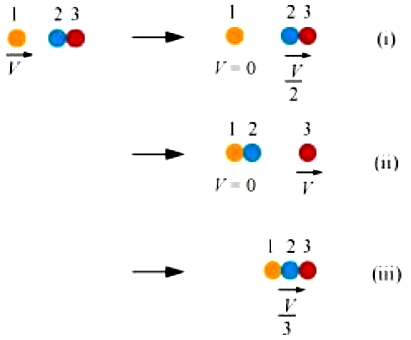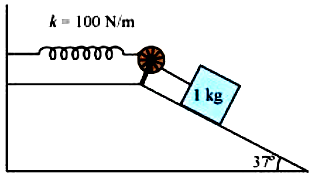A raindrop of radius \(2\) mm falls from a height of \(500\) m above the ground. It falls with decreasing acceleration (due to viscous resistance of the air) until, at half its original height, it attains its maximum (terminal) speed, and moves with uniform speed thereafter. What is the work done by the gravitational force on the drop in the first and second half of its journey?
1.
\(0\) in each half
2.
\(0.082\) J in each half
3.
\(17.87\) J in each half
4.
\(0.045\) J in each half
Two identical ball bearings in contact with each other and resting on a frictionless table are hit head-on by another ball bearing of the same mass moving initially with a speed V. If the collision is elastic, which of the following figure is a possible result after collision?

1. (i)
2. (ii)
3. (iii)
4. None of these.
The bob A of a pendulum released from 30° to the vertical hits another bob B of the same mass at rest on a table as shown in the figure. How high does bob A rise after the collision? Neglect the size of the bobs and assume the collision to be elastic.
1. Bob A will rise to a height of 0.01 m.
2. Bob A will rise to a height of 0.5 m.
3. Bob A will not rise at all.
4. Bob A will rise to a height of 0.3 m.
The bob of a pendulum is released from a horizontal position. If the length of the pendulum is 1.5 m, what is the speed with which the bob arrives at the lowermost point, given that it dissipated 5% of its initial energy against air resistance?
1. 2.5 m/s
2. 3.9 m/s
3. 4.7 m/s
4. 5.3 m/s
A body of mass 0.5 kg travels in a straight line with velocity where . What is the work done by the net force during its displacement from x = 0 to x = 2 m?
1. 50 J
2. 45 J
3. 68 J
4. 90 J
A person trying to lose weight (dieter) lifts a 10 kg mass, one thousand times, to a height of 0.5 m each time. Assume that the potential energy lost each time she lowers the mass is dissipated. How much work does she do against the gravitational force?
1. 29,000 J
2. 49,000 J
3. 21,000 J
4. 18,000 J
A family uses 8 kW of power. Direct solar energy is incident on the horizontal surface at an average rate of 200 W per square meter. If 20% of this energy can be converted to useful electrical energy, how large an area is needed to supply 8 kW?
A 1 kg block situated on a rough incline is connected to a spring of spring constant as shown in the figure. The block is released from rest with the spring in the unstretched position. The block moves 10 cm down the incline before coming to rest. The coefficient of friction between the block and the incline is:
(Assume that the spring has a negligible mass and the pulley is frictionless.)

1. 0.03
2. 0.14
3. 0.11
4. 0.08
A bolt of mass 0.3 kg falls from the ceiling of an elevator moving down at a uniform speed of 7 m/s. It hits the floor of the elevator (length of the elevator = 3 m) and does not rebound. What is the heat produced by the impact?
1. 8.82 J
2. 7.65 J
3. 7.01 J
4. 7.98 J
Which of the following potential energy curves can possibly describe the elastic collision of two billiard balls? Here r is the distance between the centres of the balls.

1. (i) and (iii)
2. (ii), (iii), and (iv)
3. (v) and (vi)
4. only (v)

